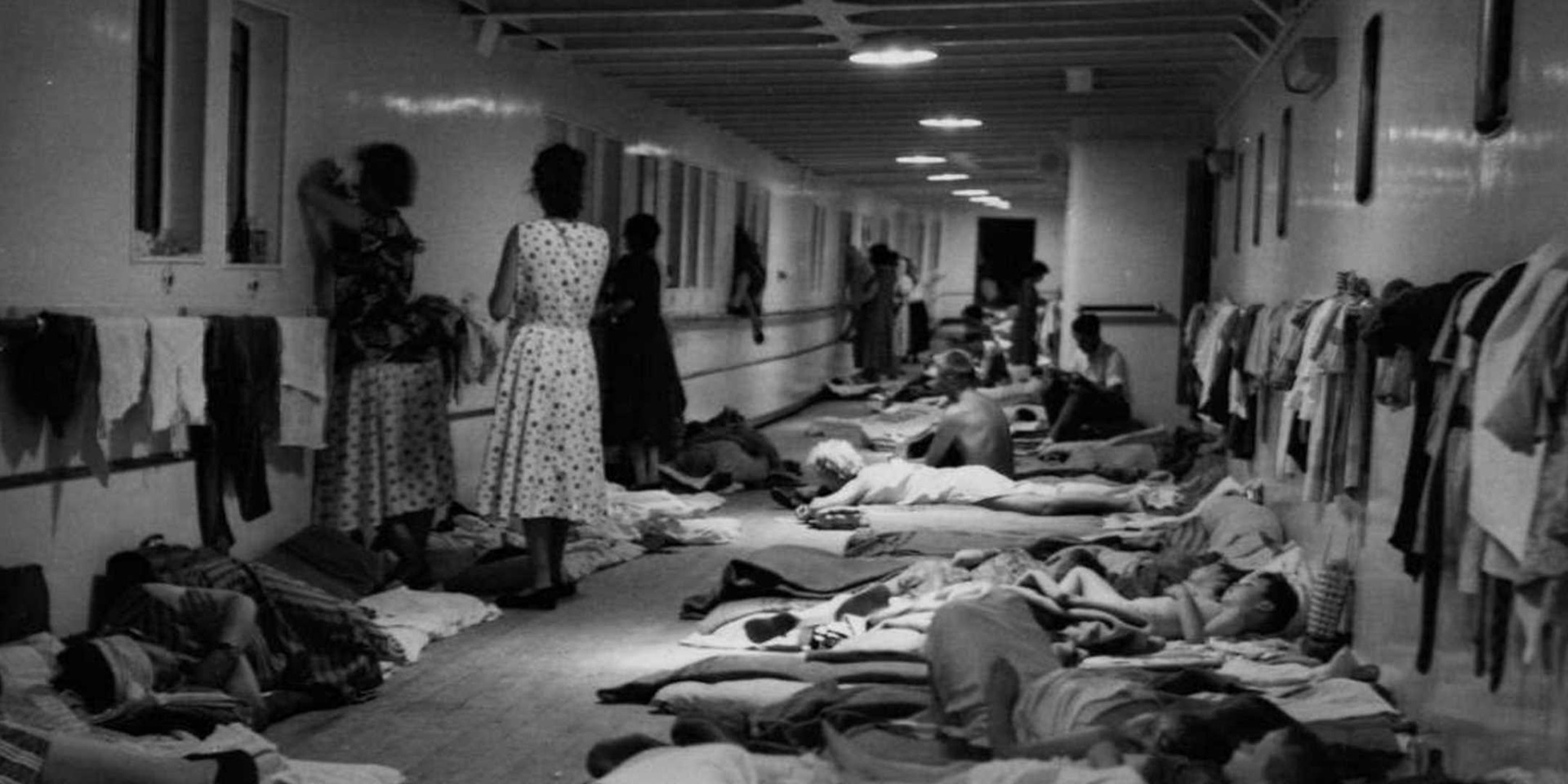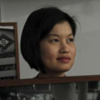
![Port bow view of the Norwegian liner Skaubryn on fire in the Indian Ocean, 1958. ANMM Collection Gift from Barbara Alysen ANMS0214[002]. Reproduced courtesy International Organisation for Migration.](https://s3-ap-southeast-2.amazonaws.com/anmm-data/blog/2018/03/28/ANMS0214002.jpg)
Port bow view of Skaubryn on fire in the Indian Ocean, 1958. ANMM Collection Gift from Barbara Alysen ANMS0214[002]. Reproduced courtesy International Organisation for Migration.
The museum holds a rich archive of photographs relating to migration (many of which are in the process of being digitised), ranging from informal family snapshots to official portraits promoting government mass migration schemes after World War II. One of our most significant collections documents the fire and rescue on the Norwegian liner Skaubryn in the Indian Ocean in 1958. A selection of these photographs is now displayed in our Tasman Light Gallery to mark the 60th anniversary of the Skaubryn disaster.
![Temporary accommodation for Skaubryn survivors on the deck of the Italian liner Roma, 1958. ANMM Collection Gift from Barbara Alysen ANMS0214[063]. Reproduced courtesy International Organisation for Migration.](https://s3-ap-southeast-2.amazonaws.com/anmm-data/blog/2018/03/28/ANMS0214063.jpg)
Temporary accommodation for Skaubryn survivors on the deck of Roma, 1958. ANMM Collection Gift from Barbara Alysen ANMS0214[063]. Reproduced courtesy International Organisation for Migration.
Remembering Skaubryn
The Skaugen liner Skaubryn was the only vessel lost at sea during the era of post-war migration to Australia. It was carrying 1,080 passengers and 208 crew when a fire broke out in the engine room on the evening of 31 March 1958. The vessel was approximately 800 miles from the British port city of Aden (now part of Yemen) and 360 miles from the African coast. Among the passengers were 736 German migrants, 168 Maltese migrants and 176 private passengers.
Within hours the passengers and crew were safely evacuated in the ship’s lifeboats, although one man, Mr Erich Walter Holz, died from a heart attack during the rescue operation. The fire destroyed the midships and forward part of Skaubryn and the vessel sank on 6 April 1958 while under tow to Aden.
![Passengers crowd into a lifeboat from Skaubryn, 1958. ANMM Collection Gift from Barbara Alysen ANMS0214[015]. Reproduced courtesy International Organisation for Migration.](https://s3-ap-southeast-2.amazonaws.com/anmm-data/blog/2018/03/28/ANMS0214015.jpg)
Passengers crowd into a lifeboat from Skaubryn, 1958. ANMM Collection Gift from Barbara Alysen ANMS0214[015]. Reproduced courtesy International Organisation for Migration.
The Intergovernmental Committee for European Migration
The museum’s Skaubryn photographs were collected by Australian journalist Keith Woodward, who was a Public Information Officer for the Intergovernmental Committee for European Migration (ICEM, now International Organisation for Migration or IOM). Woodward was based in Geneva, Switzerland, and was one of three ICEM officials who flew to Aden to help coordinate the rescue efforts. ICEM was the successor to the International Refugee Organisation (IRO), which was established to assist the millions of Europeans displaced by World War II and arrange for their resettlement in countries such as Australia, Canada and New Zealand. Skaubryn transported some 20,000 European migrants during its seven-year career and also had the distinction of carrying ICEM’s 250,000th post-war migrant in 1954.
Skaubryn carrying ICEM’s 250,000th post-war migrant to Australia, 1954. ANMM Collection Gift from Barbara Alysen ANMS0215[111]. Reproduced courtesy International Organisation for Migration.
The Skaubryn photographs
The photographs document, in incredible detail, the fire engulfing Skaubryn and the ensuing dramatic rescue at sea. Many were taken from the vantage of the British cargo ship City of Sydney, which picked up the survivors in the Indian Ocean. They were later transferred to the Flotta Lauro liner Roma and returned to Aden.
![Skaubryn survivors climb the gangway of the Flotta Lauro liner Roma, 1958. ANMM Collection Gift from Barbara Alysen ANMS0214[052]. Reproduced courtesy International Organisation for Migration.](https://s3-ap-southeast-2.amazonaws.com/anmm-data/blog/2018/03/28/ANMS0214052.jpg)
Skaubryn survivors climb the gangway of Roma, 1958. ANMM Collection Gift from Barbara Alysen ANMS0214[052]. Reproduced courtesy International Organisation for Migration.
![Passengers watch from the deck of City of Sydney as Skaubryn burns in the Indian Ocean, 1958. ANMM Collection Gift from Barbara Alysen ANMS0214[005]. Reproduced courtesy International Organisation for Migration.](https://s3-ap-southeast-2.amazonaws.com/anmm-data/blog/2018/03/28/ANMS0214005.jpg)
Passengers watch as Skaubryn burns in the Indian Ocean, 1958. ANMM Collection Gift from Barbara Alysen ANMS0214[005]. Reproduced courtesy International Organisation for Migration.
– Kim Tao, Curator
Remembering Skaubryn – 60 years on is on show until 12 September 2018.
